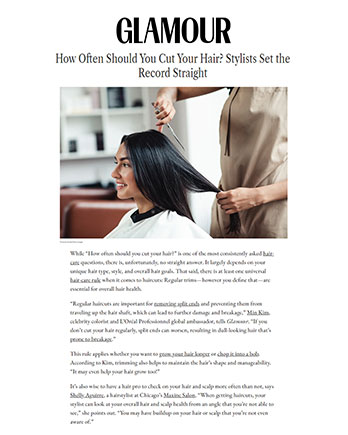Glamour March 28, 2024
 Glamour
Glamour
Hair
How Often Should You Cut Your Hair? Stylists Set the Record Straight
It depends on your hair goals.
While “How often should you cut your hair?” is one of the most consistently asked hair-care questions, there is, unfortunately, no straight answer. It largely depends on your unique hair type, style, and overall hair goals. That said, there is at least one universal hair-care rule when it comes to haircuts: Regular trims—however you define that—are essential for overall hair health.
“Regular haircuts are important for removing split ends and preventing them from traveling up the hair shaft, which can lead to further damage and breakage,” Min Kim, celebrity colorist and L’Oréal Professionnel global ambassador, tells Glamour. “If you don’t cut your hair regularly, split ends can worsen, resulting in dull-looking hair that’s prone to breakage.”
This rule applies whether you want to grow your hair longer or chop it into a bob. According to Kim, trimming also helps to maintain the hair’s shape and manageability. “It may even help your hair grow too!”
It’s also wise to have a hair pro to check on your hair and scalp more often than not, says Shelly Aguirre, a hairstylist at Chicago’s Maxine Salon. “When getting haircuts, your stylist can look at your overall hair and scalp health from an angle that you’re not able to see,” she points out. “You may have buildup on your hair or scalp that you’re not even aware of.”
In conclusion, consistent haircuts are worth it. Keep reading for everything to know about setting—and adhering to—a haircut schedule, according to your hair type, style, and needs. Before you know it, you’ll never have to google “How often should you cut your hair?” again!
How often should you cut your hair when growing it out?
If you’re growing your hair out or not maintaining a specific style, Kim says that getting a trim every 8 to 12 weeks is sufficient. “This helps to keep the ends healthy, prevent split ends, and maintain overall hair health,” she explains, and Aguirre agrees.
“When a client tells me they want to grow their hair so they just won’t get it cut for six to eight months, that is actually counterproductive,” Aguirre says. “To grow hair out, I recommend haircuts every three months. This allows that hair to grow without sacrificing the shape and keeps those split ends under control.”
Every 8 to 12 weeks
How often should you cut your hair to maintain a specific style?
“For maintaining a specific style, it’s generally recommended to schedule a haircut with your stylist every six to eight weeks to keep the shape and length intact,” says Kim. This is especially helpful if you have very layered hair or a bob haircut that needs to fall somewhere specific.
That said, it’s also up to your personal preference. “I do have clients that like their hair cut every four weeks to keep it looking sharp, so ultimately it depends on what your hair goals are,” says Aguirre.
Every four to eight weeks
How often should you cut bangs?
Bangs typically need more frequent trims than the rest of hair, says Kim, who recommends trimming them every three to four weeks. “This prevents them from getting too long and making it difficult to maintain the integrity of the style,” she says.
Every three to four weeks
How often should you cut your hair if it’s damaged or has split ends?
“If your hair is damaged or chemically treated, such as with coloring, blonding, or straightening treatments, it’s beneficial to trim more frequently,” Kim says, advising every six to eight weeks for a touch-up. Aguirre agrees, noting that a regular trim can help improve the overall health of your hair and keep damage, breakage, and split ends at bay.
Every six to eight weeks
How to maintain hair health between haircuts
Between hair cuts, Kim suggests following good hair-care routine, such as regular shampooing and conditioning with products suitable for your hair type. “Use styling tools sparingly, protect hair from environmental damage, such as sun exposure and chlorine, and nourish hair with regular deep-conditioning treatments or masks,” she says, pointing to L’Oréal Professionnel Absolut Repair Molecular Collection as her choice for combatting hair damage between appointments.
If you use hot tools, be sure to use heat protection. “There are a variety of heat protectors that specifically target each situation, and heat protection actually starts in the shower,” says Aguirre. “Also look for hot tools that reduce damage, such as Trademark Beauty Sunny Styler, which has air vents to cool the style and reduce damage along with ceramic tourmaline plates for gentleness and even heat distribution.”
Finally, Kim advises consulting with your hairstylist for personalized advice on hair care and maintenance, including the frequency of trims and the best practices for keeping your hair healthy and looking its best.
